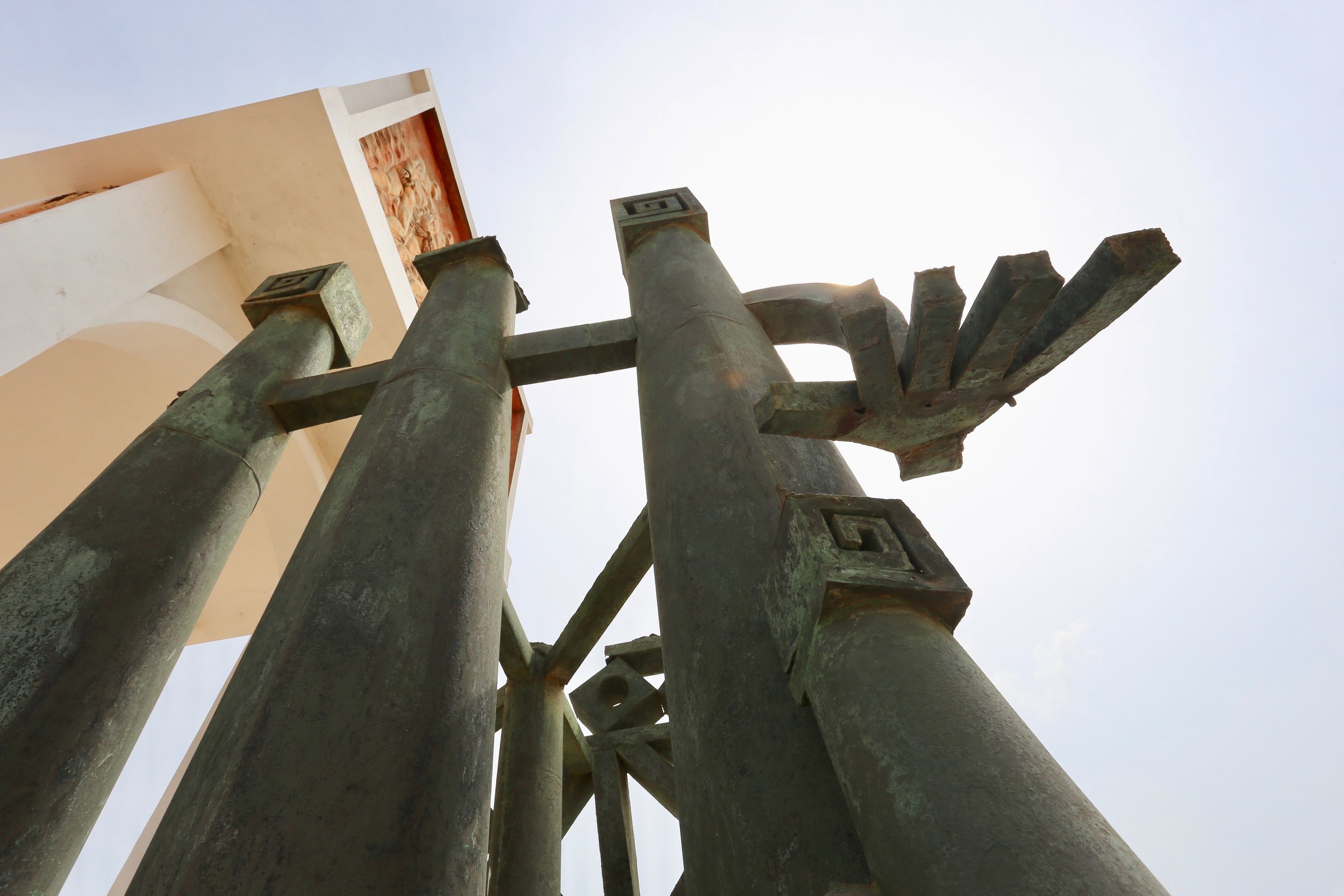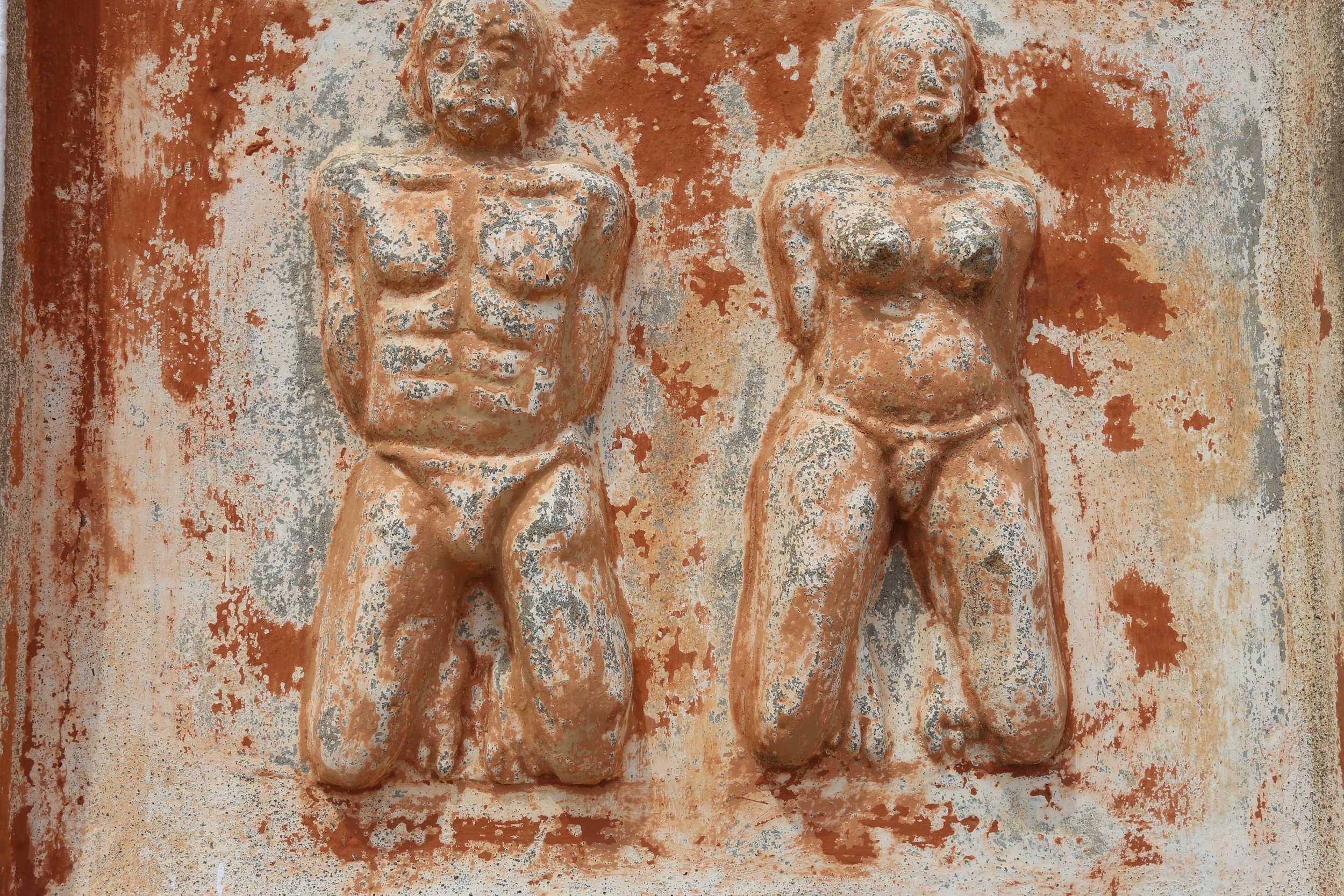
“Some sites were visited on more than one occasion over the course of years becasue their impact on my memory was so profound…Often such places embodied complex social histories but also have their own palpable stories of their battles with time and the elements; and the spirits of the people who built them.”
Excerpt from Goud case good: Conjuring Memory in Spaces of the AfroAtlantic, Dòwòti Désir
The towering Christopher Columbus column was installed to commemorate the 400th anniversary of the "discovery of America." Contested by indigenous, African and other people-of-color in the Americas, many monuments of his image have been removed. Fabricated by A. Wohlguemuth, this piece was installed in 1887. Barcelona, Spain
At the prominent La Grand Place plaza, two ornate carvings of young African males are seen carrying the load of the balcony on the facade of a building . The sculptures speak to the perception of Africans in Belgium society pre-late 20th Century. Brussels, Belgium
King Leopold II (1865-1909) the callous, brutish ruler of Belgium used the vast territory of the Congo Free State (1885-19080 as his personal playground. He was responsible for the death and maiming of 5 -10 million Congolese in the 19th-20th centuries. In 2020 his statute was defaced and toppled from its base as an effrontery to the victims of racism and colonialism. Brussels, Belgium.
Detail of enslaved captives from the Port-de-Non-Retour in Ouidah, Benin.
"Door of No-Return," Is the collaborative work of three artists. Ouidah, Benin
Interior view at the entrance of the International Slavery Museum, the first of its kind in Liverpool, England.
Inside the cell of Haitian General Governor Toussaint l'Ouverture at, Fort de Joux are a a cot, small cabinet, and fireplace. After being deceived by French commanders, l'Ouverture was kidnapped and delivered to this prison cell bordering the Swiss Alps where he perished from cold and famine in 1803. Clois de Pontarlier, France
Alison Saar sculpted the, Homage to Harriet Minty Tubman. The bronze sculpture is surrounded by decorative trees and bushes, harkening the many forests she traversed. The celebrated "Conductor of the Underground Railroad", US soldier, and spy has her likeness facing South in Harlem. New York, USA
Gracing Emancipation Park in Kingston is a couple highlighting the role that men and women played in the struggles for liberty by Afro-Jamaican peoples. Actually a fountain, the piece is named after a song written by the late national hero of the island, Bob Marley: "Redemption Song." Kingston, Jamaica
Honoring the Axosu Gbéhanzon Hossu Bowelle, is the Statute du Roi Gbèhanzin, Place Goho (1845-1906). Often referred to as the last king of Danxome, the King was an anti-colonialist who fought against the French with his all female army. He was exiled to Martinique in 1892. Abomey, Benin.
"I Am Queen Mary" one of the few statues to, and of women resistance leaders, is located in Denmark. Queen Mary (1848-1905) was one of three rebel women who lead the 1878 Fireburn of St. Croix. it is the creation of two women artists: Jeannette Ehlers and La Vaugh Belle. Copenhagen, Denmark.
The leader of the self-sustaining kilombo of Palamares is commemorated with a bronze statute. The work, "Homenagem ao Zumbi dos Palmares" is the creation of Márcia Magno and was unveiled in 2008. Unfortunately his chief strategist/warrior and wife Dandara dos Palamares has no official commemorative marker. Salvador do Bahia, Brazil
This house of prayer, Cobbs Church was built under the cover of darkness by enslaved Africans in Hamilton, Bermuda.
After getting settled and acclimatized, the descendants of the Black Loyalists who decided to stay in North America constructed their first place of worship in 1888: St Paul's Church. Birch Town, Nova Scotia, Canada
The first European enslavers of Africans were the Portuguese, yet no official monument exists in that county to the legacy of enslavement. The Antigo Mercado de Escravos is one of the few known markers of African captivity in the country. Lagos, Portugal
Interior of La Citadelle La Ferrière. The most sophisticated military fortresses in the hemisphere, has numerous hidden passages, a heating system and other notable features. Cap-Haitian, Haiti
A darkened passage of La Citadelle La Ferrière, is heavy with the presence of its former military occupants. Cap-Haitian, Haiti
Another UNESO World Heritage Site is the Royal Chapel, Cathédrale de Milot, of the Palace of San Souci, residence of King Christophe Henri, his wife, Queen Marie Louise Coidavid (1778-1851) and their children. The cathedral's dome was completely destroyed in a fire in 2020. Milot, Haiti
Among of the ruins of the Ingenio de Boca de Nigua, is this small unburned structure. The Ingenio is the site of the first rebellion led by Africans the Americas, 1521. San Cristobal, Dominican Republic
Built in 1543, La Puerta de la Misericordia, was a port of entry for enslaved Africans on the island formerly know as Quisqueya Bohio Ayiti (now shared by the Haitian and Dominican Republics). Now called the, Plaza Patriótica, public memory recalls it was a slave market although official signage indicates otherwise. Cuidad Colonial, Dominican Republic
Decorating the exterior of the homes of those who made their wealth selling Africans, and those who boasted of their ties to the what would later be deemed a "crime against humanity," are the portraits of African captives. The images are found at several structures in the largest slave trading city on continental Europe. Nantes, France
The Memorial to the Abolition of Slavery commemorates the act but manages never to address the crime itself. Unveild amidst great controversy in 2012, it was designed by Krzysztof Wodiczko and Julian Bonder.
The shameful exploits of the French Kings and Napoleon III are glorified at the Chateau Fontainebleau. This detail, focuses on the semi-circular stairway, is reminiscent of the stairs of the Maison des Esclaves at lle de Gorée, Senegal. Fontainebleau, France
The obscene wealth of the Chateau Fontainebleau which housed dynasties of French Kings, including King Louis XIV whose edicts imposed the discourse of domination known as the Code Noir, silences how so much of France's wealth was built off the blood and sweat of enslaved Africans in the Caribbean and colonized Africans on the continent. Fontainebleau, France
A small carving of an African man with lip plates is found on the side of the National Cathedral. Washington, DC, USA
The National Cathedral, has two Images of African men on opposite sides of a window. Both measure approximately 8 inches in height by 5.5 inches wide. The African presence, as builders and architects of the US capital is often forgotten. Washington. DC, USA
Burned alive in 1730 for poisoning those who tormented her when enslaved, the Sarah Sally Bassett Memorial stands at the Parliament House in Hamilton, Bermuda.
In spite of France's extortion of Haitian wealth and using apportion of monies they demanded as reparations for the loss of "their colony" to build the Eiffel Tower, "Les Heroes" recognized the courage and sacrifices of the men and women of the Haitian Revolution. A rarity in the build environment, it is among the few memorials that recognizes founding mother and fathers of a country. It was built over the course of century and a half, 1803-1953. La Gonaïves, Haiti
Headstones of Venture Smith (1729-1805) and his wife Meg. The 18th century self-manumitted African was born in Guinea but hailed from a dungeon in Anomabo, Ghana. As he amassed a tremendous amount of land, hiring Blacks and whites to work from him, he witnessed two great Revolutions in his life: The American Revolution 1775-1776, and the Haitian Revolution 1791-1803. Haddam, Connecticut, USA





























